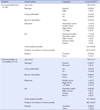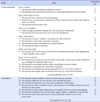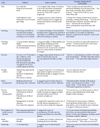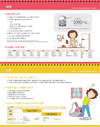Abstract
Purpose
The purpose of this study was to develop and evaluate the quality (understandability and actionability) of health education materials for Korean-Chinese (KC) female migrant workers, using Patient Education Materials Assessment Tool for Printable Materials (PEMAT-P).
Methods
Educational needs assessment was conducted with 3 focus groups with 20 KC women and a focus group with 4 community stakeholders. The quality of the educational materials was evaluated by 3 experts and a community stakeholder, followed by a survey with 15 KC women using 17 items for understandability and 7 items for actionability by means of a Korean version PEMAT-P.
Results
The health educational calendar consists of 12 subjects out of 9 topics related to healthy lifestyles for preventing cardiovascular diseases. The overall mean understandability score was 98.8% and the overall mean actionability was 100%.
Conclusion
Involvement of KC women and community stakeholders in the development of educational materials was found to be an effective strategy for increasing understandability and actionability of educational materials for KC female migrant workers. This study also demonstrates the PEMAT-P is a useful evaluation tool, emphasizing the actionability of educational materials.
Figures and Tables
Table 1
Characteristics of Korean-Chinese Women in the Study

Table 2
Understandability & Actionability of Educational Materials Perceived by Korean-Chinese Women Participants (N=15)

Table 3
Development of Educational Materials

References
1. Ministry of the Interior. 2015 Foreign residents survey results [Internet]. Seoul: Ministry of the Interior;2015. cited 2016 January 08. Available from: http://www.mogaha.go.kr/frt/bbs/type001/commonSelectBoardArticle.do?bbsId=BBSMSTR_000000000014&nttId=46327.
2. Korean Immigration Service. 2015 Korean immigration service yearly statistics [Internet]. Gyeonggi Korean Immigration Service;2016. cited 2016 September 13. http://www.immigration.go.kr/HP/COM/bbs_003/ListShowData.do?strNbodCd=noti0096&strWrtNo=129&strAnsNo=A&strOrgGbnCd=104000&strRtnURL=IMM_6050&strAllOrgYn=N&strThisPage=1&strFilePath=imm/http://www.immigration.go.kr/HP/COM/bbs_003/ListShowData.do?strNbodCd=noti0096&strWrtNo=129&strAnsNo=A&strOrgGbnCd=104000&strRtnURL=IMM_6050&strAllOrgYn=N&strThisPage=1&strFilePath=imm/.
3. Lee H, Chae DH, Lee KE, Lee MH. Experiences of middle-aged Korean-Chinese female migrant workers in Korea: With focus on risk factors in work-related musculoskeletal diseases. J Korean Acad Community Health Nurs. 2013; 24(2):185–194. DOI: 10.12799/jkachn.2013.24.2.185.

4. Chung KS, Kim SH, Ko JY, Lee KY, Lee HK, Lee CW, et al. 2013 Survey on living conditions of foreign workers. 2013 Ministry of Justice Service Report. Gyeonggi-do: Korea Immigration Service · Ministry of Justice;2013. 12. Report No.: 11-1270000-000802-01.
5. Lee H, Cho SH, Kim YK, Kim JH. Is there disparity in cardiovascular health between migrant workers and native workers? Workplace Health Saf. 2016; 64(8):350–358. DOI: 10.1177/2165079916633222.

6. Lee SJ, Chung CW. Comparisons of health conditions of immigrant and domestic women in Korea and China using propensity score matching. Health Care Women Int. 2013; 34(11):989–1004. DOI: 10.1080/07399332.2012.741636.

7. Sim KH. Tips for creating effective health education materials. J Korean Diabetes. 2011; 12(2):99–103. DOI: 10.4093/jkd.2011.12.2.99.

8. U.S. Department of Health and Human Services. Quick guide to health literacy [Internet]. Maryland, MD: Department of Health and Human Services;2010. cited 2016 March 14. Available from: http://health.gov/communication/literacy/quickguide/Quickguide.pdf.
9. Brega AG, Freedman MA, LeBlanc WG, Barnard J, Mabachi NM, Cifuentes M, et al. Using the health literacy universal precautions toolkit to improve the quality of patient materials. J Health Commun. 2015; 20:sup2. 69–76. DOI: 10.1080/10810730.2015.1081997.

10. Shoemaker SJ, Wolf MS, Brach C. Development of the patient education materials assessment tool (PEMAT): A new measure of understandability and actionability for print and audiovisual patient information. Patient Educ Couns. 2014; 96(3):395–403.

11. Cajita MI, Rodney T, Xu J, Hladek M, Han HR. Quality and health literacy demand of online heart failure information. J Cardiovasc Nurs. 2016; Forthcoming. DOI: 10.1097/JCN.0000000000000324.

12. Krueger RA, Casey MA. Focus groups: A practical guide for applied research. 5th ed. California, CA: Sage Publications;2014. p. 280.
13. Griffiths J, Maggs H, George E. 'Stakeholder involvement' background paper prepared for the who/wef joint event on preventing noncommunicable diseases in the workplace (Dalian/China, September 2007). WHO Report. Geneva, Switzerland World Health Organization: 2008.
14. Delbecq AL, Van de Ven AH, Gustafson DH. Group techniques for program planning: A guide to nominal group and delphi processes. 1st ed. Glenview, Illinois: Scott, Foresman;1975. p. 174.
15. Brunette MJ. Development of educational and training materials on safety and health. targeting hispanic workers in the construction industry. Fam Community Health. 2005; 28(3):253–266.
16. Yang SJ, Chee YK, An J, Park MH, Jung S. Health literacy and its associated factors in Korean-Chinese and other Asian immigrant women in Korea. J Korean Public Health Nurs. 2014; 28(2):211–227. DOI: 10.5932/JKPHN.2014.28.2.211.

17. Shoemaker SJ, Wolf MS, Brach C. The patient education materials assessment tool (PEMAT) and User's guide [Internet]. USA: Agency for Healthcare Research and Quality;2013. cited 2016 March 16. Available from: http://www.ahrq.gov/sites/default/files/publications/files/pemat_guide.pdf.
18. Behling O, Law KS. Translating questionnaires and other research instruments: Problems and solutions. Vol. 133. Thousand Oaks, California, London: Sage Publications;2000. p. 80.
20. Hsieh HF, Shannon SE. Three approaches to qualitative content analysis. Qual Health Res. 2005; 15(9):1277–1288. DOI: 10.1177/1049732305276687.

21. Zellmer C, Zimdars P, Parker S, Safdar N. How well do patient education materials for clostridium difficile infection score? A systematic evaluation. Int J Infect Control. 2015; 11(2):1–4. DOI: 10.3396/IJIC.v11i2.010.15.

22. Peters GJ. A practical guide to effective behavior change: How to identify what to change in the first place. Eur Health Psychol. 2014; 16(5):142–155.

23. Pearson TA, Palaniappan LP, Artinian NT, Carnethon MR, Criqui MH, Daniels SR, et al. American heart association guide for improving cardiovascular health at the community level, 2013 update: A scientific statement for public health practitioners, healthcare providers, and health policy makers. Circulation. 2013; 127(16):1730–1753. DOI: 10.1161/CIR.0b013e31828f8a94.
24. Griffiths C, Motlib J, Azad A, Ramsay J, Eldridge S, Feder G, et al. Randomised controlled trial of a lay-led self-management programme for Bangladeshi patients with chronic disease. Br J Gen Pract. 2005; 55(520):831–837.
25. Joseph RP, Keller C, Adams MA, Ainsworth BE. Print versus a culturally-relevant facebook and text message delivered intervention to promote physical activity in African American women: A randomized pilot trial. BMC Womens Health. 2015; 15:30. DOI: 10.1186/s12905-015-0186-1.

26. De Jesus-Rivas M, Conlon HA, Burns C. The impact of language and culture diversity in occupational safety. Workplace Health Saf. 2016; 64(1):24–27. DOI: 10.1177/2165079915607872.

27. Basch CE. Focus group interview: An underutilized research technique for improving theory and practice in health education. Health Educ Q. 1987; 14(4):411–448.

28. Kandula NR, Khurana NR, Makoul G, Glass S, Baker DW. A community and culture-centered approach to developing effective cardiovascular health messages. J Gen Intern Med. 2012; 27(10):1308–1316. DOI: 10.1007/s11606-012-2102-9.

29. Henderson S, Kendall E, See L. The effectiveness of culturally appropriate interventions to manage or prevent chronic disease in culturally and linguistically diverse communities: A systematic literature review. Health Soc Care Community. 2011; 19(3):225–249. DOI: 10.1111/j.1365-2524.2010.00972.x.





 PDF
PDF ePub
ePub Citation
Citation Print
Print




 XML Download
XML Download